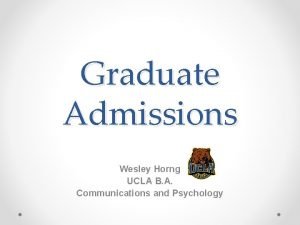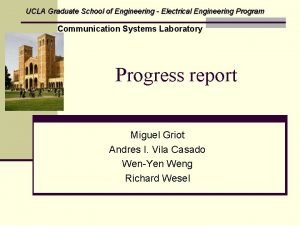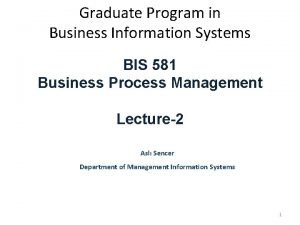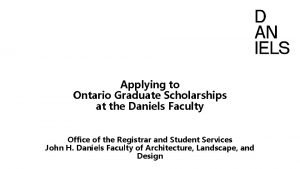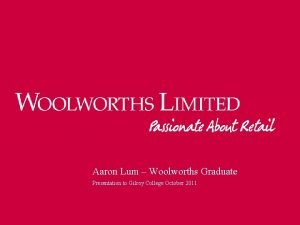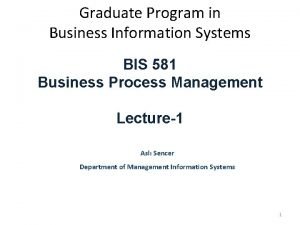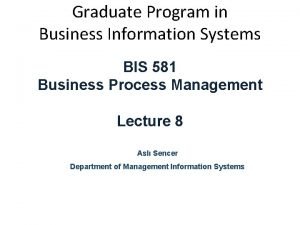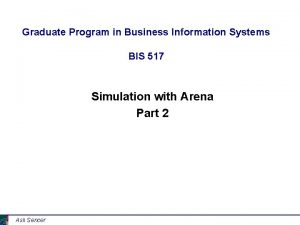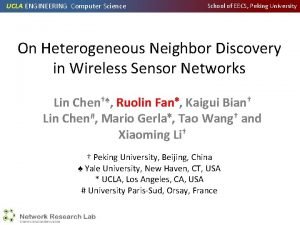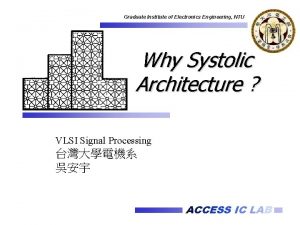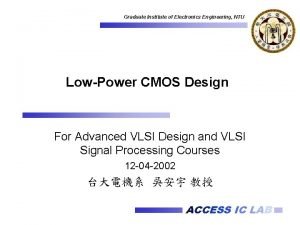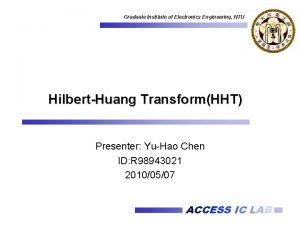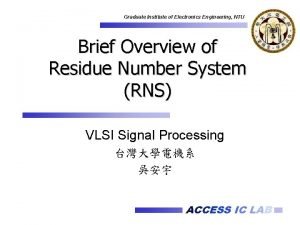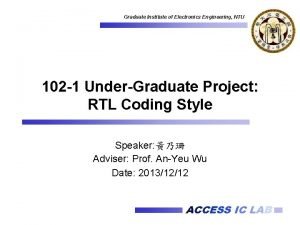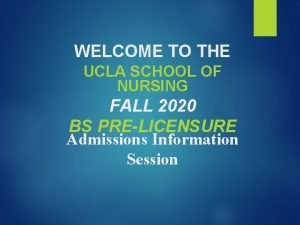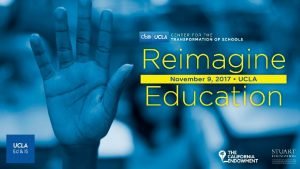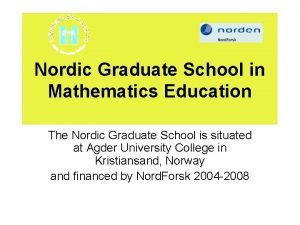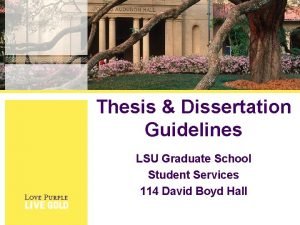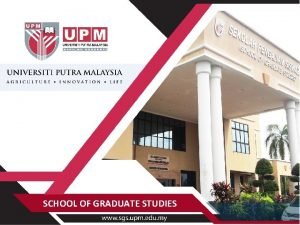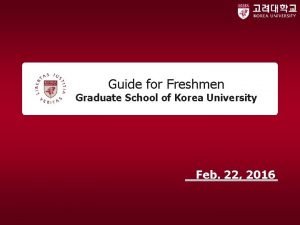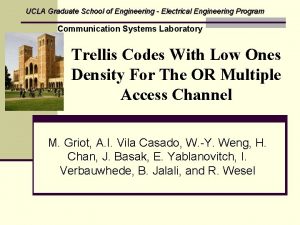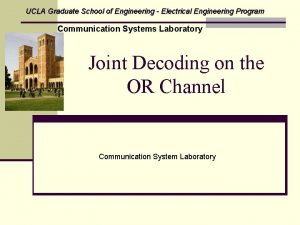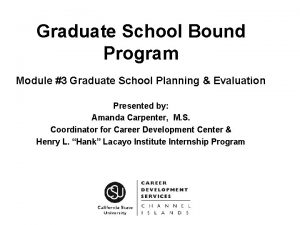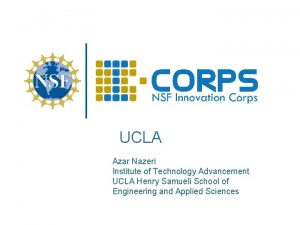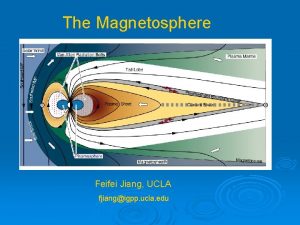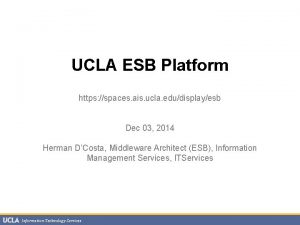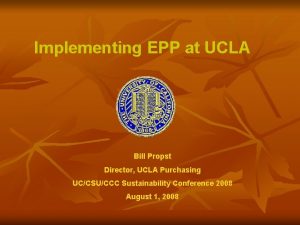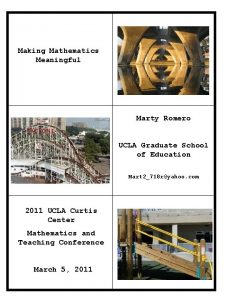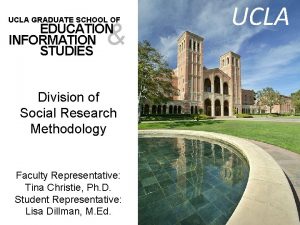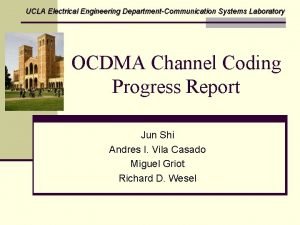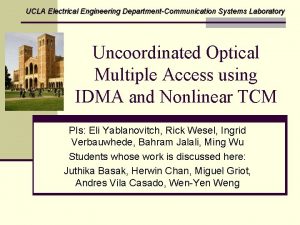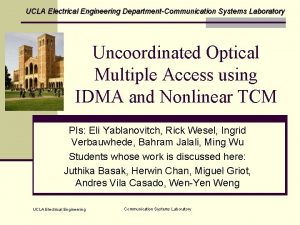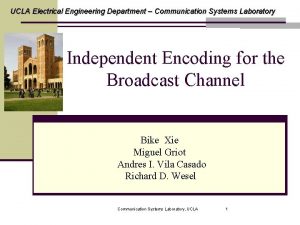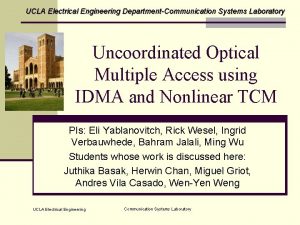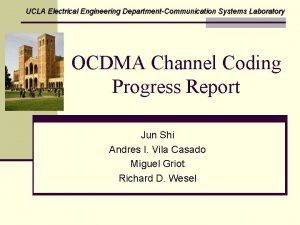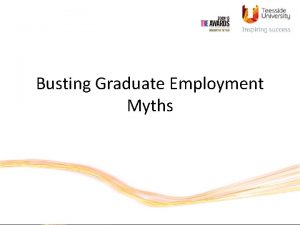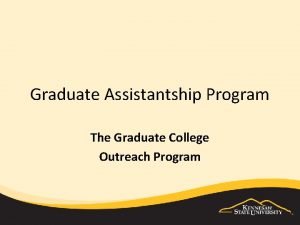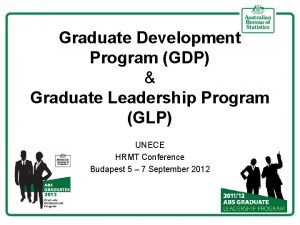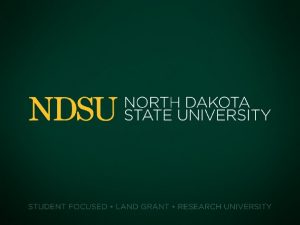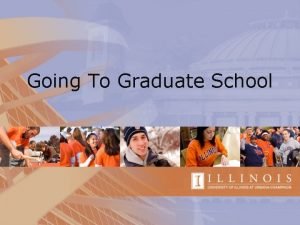UCLA Graduate School of Engineering Electrical Engineering Program




























- Slides: 28

UCLA Graduate School of Engineering - Electrical Engineering Program Communication Systems Laboratory Progress report Miguel Griot Andres I. Vila Casado Wen-Yen Weng Richard Wesel

Results up to last meeting n Non-linear trellis codes for OR-MAC (Completed) n Design criteria. n BER analytical bounding technique. n Results for any number of users. n Parallel concatenated NLTC for OR-MAC n Design criteria. n BER analytical bounding technique. n Results for 6 and 24 users. n Theoretically achievable Sum-rates for more general channels, in particular coherent interference model. n Preliminary results for 6 -user optical MAC with coherent interference, using NLTC.

Non-linear trellis codes for OR-MAC n Design Criteria: n Extension to Ungerboeck’s rules. n We maximize the minimum free distance of the code, using the proper directional distance definition for the Z-Channel. n BER bounding technique for Z-Channel n Transfer function bound technique.

Bit Error Rate Bound for the Z-Channel n We use the transfer function bound technique on [Viterbi ‘ 71] for linear codes, and extended by [Biglieri ‘ 90] for non-linear codes, modifying the pairwise error probability measure. n Given two codewords n Replace and the transfer function bound technique can be readily applied to the NLTC to yield an upper bound to its BER over the Z-Channel.

Bit Error Rate Bound for the Z-Channel n Product states: where and denote the state at the encoder and receiver respectively. G denotes a ‘good product-state’ and B denotes a ‘bad product-state’. n Transition matrix: n For each transition in the product-state diagram the branch is labeled as: n

Bit Error Bound for the Z-Channel n Transfer function: where: n Then:

Results : 6 -user OR-MAC

Large number of users n Main results: n For any number of users, we achieve the same sum -rate with similar performance. N n SR 6 20 0. 3 0. 439 100 344 0. 291 0. 4777 300 1000 0. 3 0. 4901 900 3000 0. 3 0. 4906 1500 5000 0. 3 0. 4907 n BER Tight BER analytical bound for Z-Channel provided.

Concatenation with Outer Block Code n A concatenation of an NLTC with a high rate block code provides a very low BER, at low cost in terms of rate. Block-Code Encoder NL-TC Encoder Z-Channel Block-Code Decoder n n NL-TC Decoder Results: n A concatenation of the rate-1/20 NL-TCM code with (255 bytes, 247 bytes) Reed-Solomon code has been tested for the 6 -user OR-MAC scenario. n This RS-code corrects up to 8 erred bits. Rate Sum-rate p 0. 0484 0. 29 0. 125 BER 0. 4652 Although we don’t have simulations for the 100 -user case, it may be inferred that a similar BER would be achieved.

Parallel Concatenated NL-TCs n Capacity achieving. NL-TC Interleaver NL-TC n Design criteria: n An extension of Benedetto’s uniform interleaver analysis for parallel concatenated non-linear codes has been derived. n This analysis provides a good tool to design the constituent trellis codes.

Parallel Concatenated NL-TCs n The uniform interleaver analysis proposed by Benedetto, evaluates the bit error probability of a parallel concatenated scheme averaged over all (equally likely) interleavers of a certain length. n Maximum-likelihood decoding is assumed. n However, this analysis doesn’t directly apply to our codes: n n n It is applied to linear codes, the all-zero codeword is assumed to be transmitted. The constituent NL-TCM codes are non-linear, hence all the possible codewords need to be considered. In order to have a better control of the ones density, non-systematic trellis codes are used in our design. Benedetto’s analysis assumes systematic constituent codes. An extension of the uniform interleaver analysis for non -linear constituent codes has been derived.

Results • Parallel concatenation of 8 -state, duo-binary NLTCs. • Sum-rate = 0. 6 • Block-length = 8192 • 12 iterations in message-passing algorithm 6 users

General Model for Optical MAC User 1 User 2 User N Receiver if all users transmit a 0 if one and only one user transmits a 1 if m users transmit a 1 and the rest a 0

Model n The can be chosen any way, depending on the actual model to be used. n Examples: n Coherent interference: threshold n n constant

Achievable sum-rates n n users with equal ones density p. n Joint Decoding n Treating other users as noise – Binary Asymmetric Channel: 1 1 0 0

Sum-rate for coherent interence We provide an analytical lower bound to the achievable sum-rate for ANY number of users, for both joint decoding and treating other users as noise.

Lower bound for different n This figure shows the lower bounds and the actual sum-rates for 200 users for the worst case ( Coherent interference JD : Joint Decoding OUN: Other Users Noise constant).

Progress since last meeting n New FPGA demo for 6 -user optical multiple access. n Design of NL-TC for optical MAC with coherent interference, for large number of users. n BER bounding technique for BAC. n (Ongoing work) Design of parallel concatenated NLTC for optical MAC with coherent interference.

Progress: publications & presentations Trellis Codes with Low Ones Density for the OR Multiple Access Channel, M. Griot, A. Vila Casado, W-Y Weng, H. Chan, J. Basak, E. Yablanovitch, I. Verbauwhede, B. Jalali, R. Wesel. IEEE ISIT, Seattle, 9 -14 July 2006. n Presented in IEEE ISIT 2006 by Miguel Griot. n Non-linear Turbo Codes for Interleaver-Division Multiple Access on the OR Channel, M. Griot, A. Vila Casado, R. Wesel. To be presented at IEEE GLOBECOM Technical Conference 2006, Nov. 27 – Dec. 1, San Francisco. n Presentation: Demonstration of Uncoordinated Multiple Access in Optical Communications, H. Chan, A. Vila Casado, J. Basak, M. Griot, W-Y Weng, E. Yablanovitch, I. Verbauwhede, R. Wesel. 2006 43 rd Design Automation Conference, July 24 -28, San Francisco. n Winner of the 2006 DAC/ISSCC Student Design Contest 1 st Prize award, on the Operational System Design category. n Presented by Herwin Chan. n Journal Papers under preparation: n Non-linear Trellis Codes for Interleaver-Division Multiple Access on optical channels. (IEEE Trans. Telecommunications) n Includes material presented on ISIT 2006, and NL-TC codes for BAC. n Non-linear Turbo Codes for Interleaver-Division Multiple Access on optical channels. n Includes material to be presented on Globe. Com 2006, and PC-NLTC codes for BAC. (IEEE Trans. Telecommunications) n Demonstration of Uncoordinated Multiple Access in Optical Communications. n Includes material presented in DAC Conference 2006. n

BER analytical bound

Results for 6 -user MAC n 64 -state, rate 1/30 NLTC (Sum-rate = 0. 2) n Coherent interference model (CI-MAC): threshold n Z-Channel:

BER bound for 6 -user CI-MAC • 64 -state NL-TC

Results for Optical MAC n Model: Coherent interference n 128 -state NL-TC n Sum-rate = 0. 2 Users 6 32 104 p α 0. 2832 0. 3107 0. 3147 β 0. 0622 0. 0664 0. 0677 BER

Simulator Features n Random data is generated and encoded n The signal passes through a parameterizable channel model n Probes are placed at different point of the receiver to see how the codes react to changes in the channel

Channel Model n a and b simulate the degradation of the transmitted signal due to interference from other transmitters n a – non-coherent combination Probability that a 0 bit turns into 1 n b – coherent combination Probability that a 1 bit turns into 0

FPGA Channel Simulator FPGA transmitter Channel Model a Trellis Decoder Rate: 1/20 BER < 10 -5 Reed Solomon Decoder (255, 237) b n Hardware transmitter, receiver and channel model simulated on a single FPGA n Effects of changing channel parameters can be evaluated in real time n New Channel codes can be easily tested BER < 10 -9

Measurement Points FPGA transmitter Channel Model a • Ones density • Channel Errors • One to zero transitions Trellis Decoder Rate: 1/20 BER < 10 -5 Reed Solomon Decoder (255, 237) b Non-linear trellis code bit error rate Total bit error rate BER < 10 -9

Simulation Interface Real time channel conditions Bit error rate measurement at receiver Channel parameter selection n Real-time Matlab graphical user interface n Real-time control of channel parameters a and b
 Wesley horng
Wesley horng Ucla ee department
Ucla ee department Ucla ece graduate
Ucla ece graduate Graduate school of engineering science osaka university
Graduate school of engineering science osaka university Klipsch school of electrical and computer engineering
Klipsch school of electrical and computer engineering University of belgrade school of electrical engineering
University of belgrade school of electrical engineering Bis graduate program
Bis graduate program Daniels registrar
Daniels registrar Woolworths graduate program
Woolworths graduate program Kpmg law graduate program
Kpmg law graduate program Bis graduate program
Bis graduate program Asean graduate program
Asean graduate program Bis graduate program
Bis graduate program Bis graduate program
Bis graduate program Video auchan
Video auchan Computer science and engineering ucla
Computer science and engineering ucla Graduate institute of electronics engineering
Graduate institute of electronics engineering Graduate institute of electronics engineering
Graduate institute of electronics engineering Graduate institute of electronics engineering
Graduate institute of electronics engineering Graduate institute of electronics engineering
Graduate institute of electronics engineering Graduate institute of electronics engineering
Graduate institute of electronics engineering Ucla school of nursing
Ucla school of nursing Ucla nursing application
Ucla nursing application Mark covin ucla
Mark covin ucla Horace mann ucla community school
Horace mann ucla community school Nordic studies in mathematics education
Nordic studies in mathematics education Lsu thesis statement
Lsu thesis statement School of graduate studies upm
School of graduate studies upm Sugang.korea.ac.kr.graduate
Sugang.korea.ac.kr.graduate
